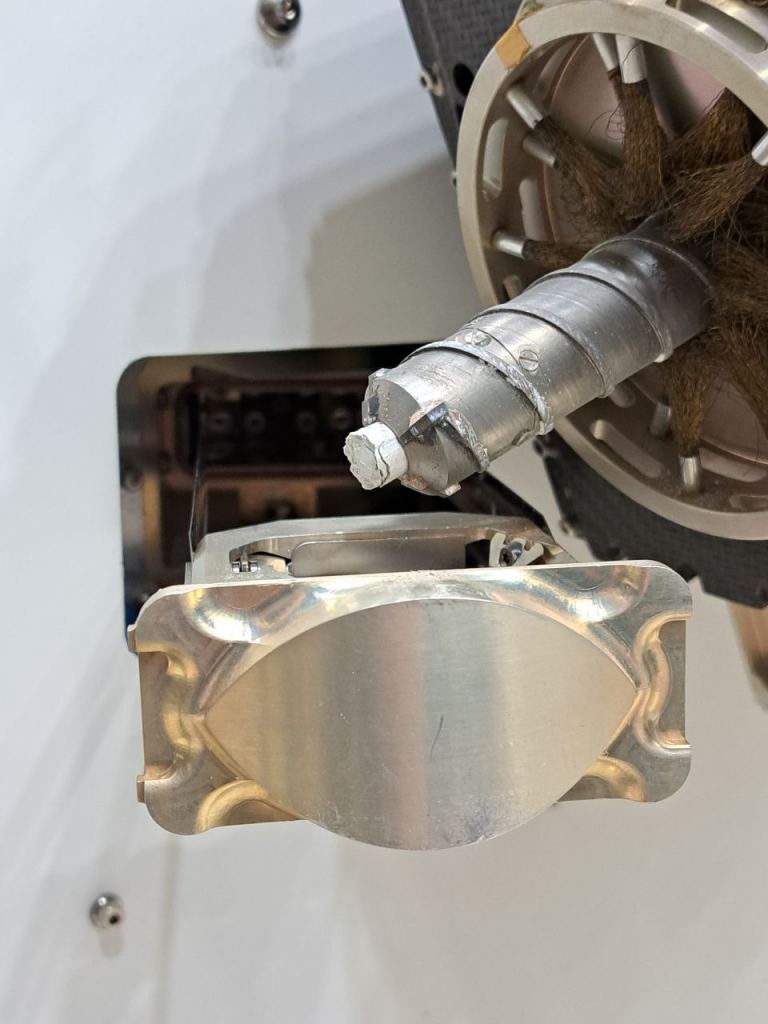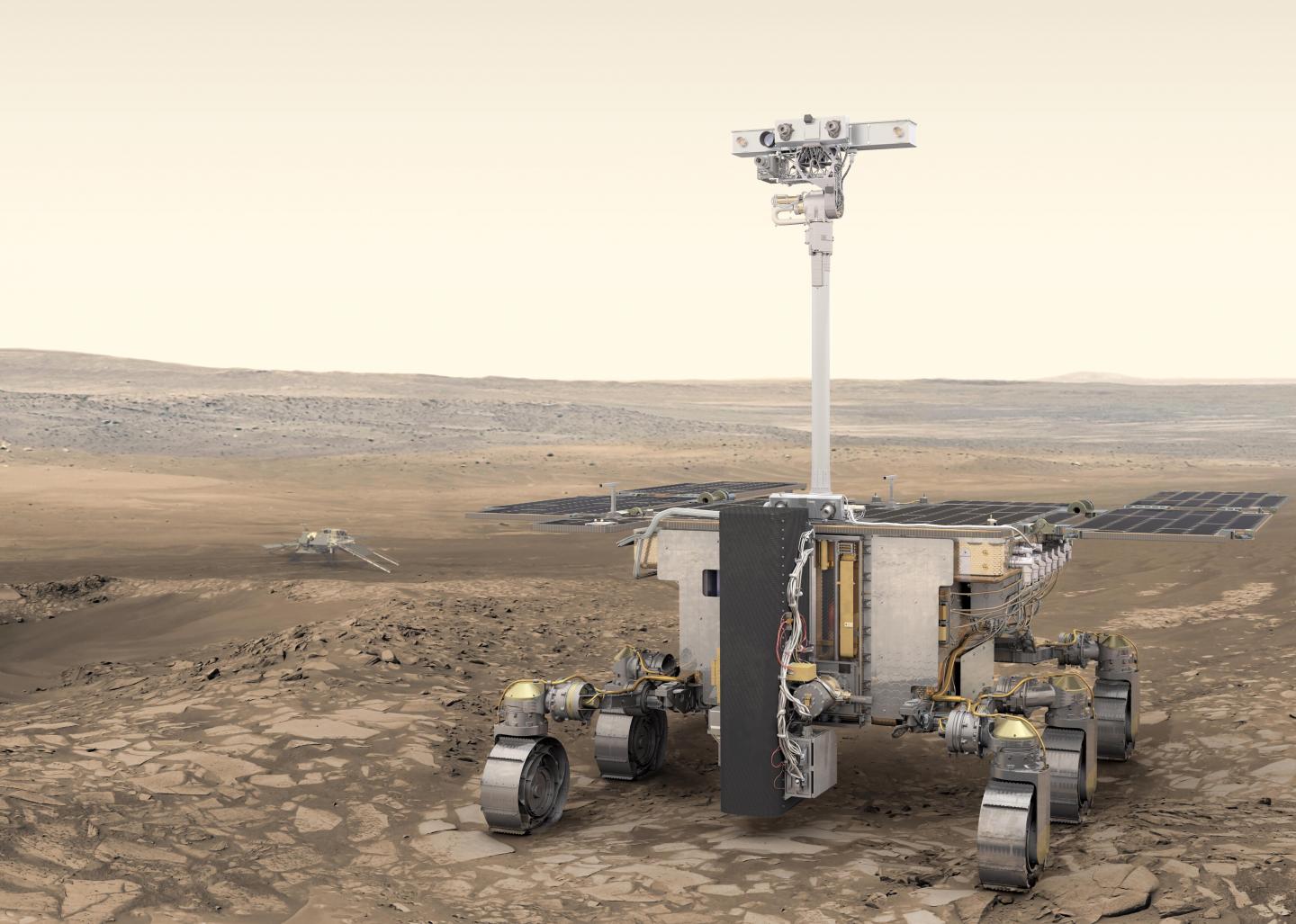The ExoMars Rover mission is back on track for its mission to Mars, but Russia won’t be a part of it this time. Following Russia’s disastrous invasion of neighbouring Ukraine in February 2022, the ESA suspended the ExoMars program.
Now, the mission is targeted for a 2028 launch to Mars without Russian involvement. In anticipation of that launch date, the ESA is busy testing the Rosalind Franklin rover and its mission-defining drill.
“ExoMars is being re-shaped for this new enterprise, with new forces and energies joining the project team, once again fully motivated and focused on setting out the next steps.”
Statement from the ESA.
The ExoMars program was a partnership between the ESA and Roscosmos. It started with the 2016 launch that put the Trace Gas Orbiter (TGO) in orbit around Mars and attempted to land the Schiaparelli EDM lander on the Martian surface. The TGO succeeded, but unfortunately, Schiaparelli crashed and was destroyed.
The next part of the ExoMars program was supposed to involve a Roscosmos lander that would’ve delivered the Rosalind Franklin rover to the surface of Mars. But the ESA has reinvented the mission, and in an FAQ, they said it would take three or four years to design and build a new European lander that will deliver Rosalind Franklin to Mars. That delay, combined with available launch windows, led to the ESA rescheduling the mission for 2028.

The Rosalind Franklin rover is unique. It’ll collect samples like NASA’s Perseverance rover can, but while Perseverance’s samples are from the surface, Rosalind Franklin’s drill can penetrate to a depth of two meters to obtain samples. The ESA has been testing the drill on the Franklin’s twin, Amalia, at the ALTEC (Aerospace Logistics Technology Engineering Company) premises.

Sub-surface samples are desirable because that’s where well-preserved material from Mars’ life-supporting past might be located. And while the samples won’t be travelling to Earth for analysis, the rover’s Analytical Laboratory Drawer (ALD) contains a suite of instruments that will study the samples. The ALD contains three instruments for this purpose. An infrared spectrometer called the MicrOmega Instrument, a Raman spectrometer, and the Mars Organics Molecular Analyzer (MOMA.) MOMA is a combination of a gas chromatograph and a Laser Desorption Mass Spectrometer.
The Rosalind Franklin rover will land at the Oxia Planum region, one of the largest regions of exposed, clay-rich rocks on Mars. Oxia Planum is a 200 km wide region containing clays about 3.8 billion years old. Scientists think that Mars harboured surface water and may have been habitable at that time, which is called the Hesperian Period. The ancient rocks at Oxia Planum may hold evidence of ancient life, maybe buried beneath the surface.

The MOMA instrument will play a critical role in the search for evidence of life. Its job is to detect and identify organic material in drill samples. If it finds some, it’s equipped to determine if the organic material is biotic or abiotic. It does this by volatilizing the samples. It can either heat them to produce vapours, or it can use intense UV laser pulses to “… induce prompt desorption into the gas phase,” as scientists involved with the instrument describe it. Once vaporized, the samples can be studied spectroscopically.
Detecting organics on Mars is no simple task. Interplanetary dust and meteorites have likely delivered large quantities of abiotic organic molecules to Mars. Characterizing this background organic material is part of the rover’s job.
There will likely never be a “slam-dunk” biomarker on Mars that everyone agrees on. But a pragmatic approach involves molecules called lipids and phospholipids. These molecules can form cell membranes and can be preserved over geologic timescales. Both types can form abiotically, but biotic ones are different. If they’re biotic, they’re likely present in high concentrations over a narrow range of molecular weights.
But MOMA and the other instruments can only succeed if Rosalind Franklin’s drill succeeds. That’s why the ESA is testing the drill so thoroughly before the mission launches. And that’s why they built a twin rover named Amalia.

The Russian invasion of Ukraine is a tragedy in our time, as cities are destroyed, and lives are snuffed out. The pure criminality of it reverberates around the world. But the invasion is exacting a scientific price, too.
The ExoMars program is an ambitious endeavour, and excluding Russia means the ESA has a lot of extra work to do. Prior to Russia’s invasion of Ukraine, the ExoMars spacecraft was scheduled to be sent to the Baikonur launch site in April 2022. But instead of reaching that milestone, things were dismantled. Two Russian scientific instruments had to be removed and returned to Russia.
“The knock-on effect has vast implications: the built flight hardware needs to be returned to each of the former partners, and then ESA’s elements will need maintenance and refurbishment, while new ESA developments and technologies are now required to fill the void of the elements originally provided by Roscosmos,” the ESA explains.
People involved with the mission are disappointed and, until now, have been wondering if their years of work and dedication were wasted. According to the ESA, there’s a new enthusiasm surrounding the mission. Its scientific objectives are as laudable as they ever were, and the mission’s potential is undiminished. “ExoMars is being re-shaped for this new enterprise, with new forces and energies joining the project team, once again fully motivated and focused on setting out the next steps,” the ESA writes.
If all goes well, the Rosalind Franklin rover will land at Oxia Planum in October 2030. About one month after that, when it’s tested its systems and instruments and imaged its surroundings, it’ll begin drilling. Once that begins, the scientific data will start flowing.
Step by step, missions to Mars are uncovering the planet’s ancient past and habitability. From the Viking program to Spirit and Opportunity, then to MSL Curiosity and Perseverance, a series of robotic explorers have removed much of the mystery surrounding Mars.
But the main question remains unanswered: Did Mars support life?
Starting in 2030, we may finally get an answer to that, thanks to the ESA and their ExoMars program.
More:
- Press Release: ExoMars precious sampling
- ESA FAQ: The ‘rebirth’ of ESA’s ExoMars Rosalind Franklin mission
- Science Article: The Mars Organic Molecule Analyzer (MOMA) Instrument: Characterization of Organic Material in Martian Sediments
- Universe Today: Europe’s ExoMars Rover Will Likely Miss This Year’s Launch Window Because of Russia’s Invasion of Ukraine

